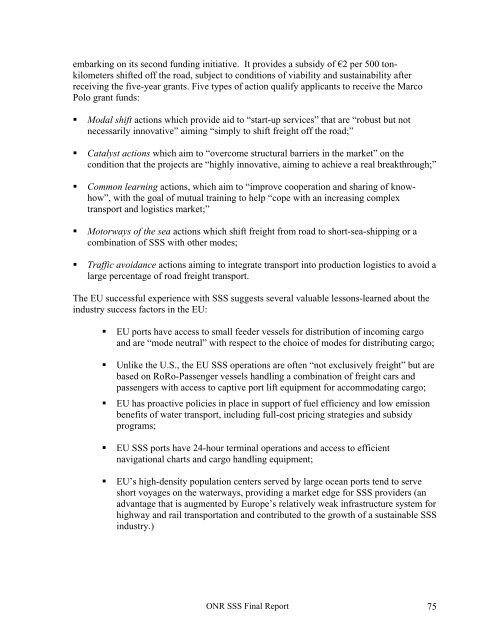elive congestion at a Tier 1 port such as ports <strong>of</strong> New York/New Jersey while continuing t<strong>of</strong>ill available capacity at their own facilities. Expanding a feeder port system would not onlyreduce the adverse impacts <strong>of</strong> congestion at Tier 1 international ports, it would also addcapacity and promote economic development in small port areas, as the CEO <strong>of</strong> HorizonLines, a shipping company that has had difficulties in sustaining its container feederoperations on self-propelled vessels has suggested. 93Efficiency <strong>of</strong> practices involving the development <strong>of</strong> inland distribution centers for“transshipment” <strong>of</strong> international cargo imports, <strong>of</strong>ten used interchangeably with “feedering,”closely hinges on the availability <strong>of</strong> small feedering vessels and SSS services. The PortInland Distribution Network (PIDN) developed in the New York/New Jersey area, anddistribution center developed in the Southern California Empire Valley, for instance, areexamples <strong>of</strong> the practice <strong>of</strong> transshipping goods from one shipping line/vessel to another, orfrom one type <strong>of</strong> container to another. Container transshipment today <strong>of</strong>ten involvesshipping the container on truck to a distribution center for reloading, sorting, and valueaddedoperations. The practice has become a growing component <strong>of</strong> the strategy pursued bymany vessel operators that take advantage <strong>of</strong> available ground intermodal connections toreduce the number <strong>of</strong> port calls and transship cargo to and from such a PIDN by relying on athrough-bill-<strong>of</strong>-lading (BOL).The domestic feeder connectors would provide an efficient hub & spoke network for movinginternational containers on their domestic leg. In the recent years, growth in marine-relatedhub & spoke networks has been fueled by increased vessel size that have compelled carriersto reduce the number <strong>of</strong> ports directly called. For new coastal SSS services to be viable theyneed to be fully integrated with the existing and emerging port networks. Furthermore, sincethe nation’s intercity trucks and rail carriers also use the same hub & spoke models forcarrying international containers, SSS services need to be closely connected to them. Suchan integrated network <strong>of</strong> well connected hub & spokes to strategically located PIDN anddistribution centers utilizing the coastal routes and the inland waterways would fosterdevelopment <strong>of</strong> an efficient feedering network to reduce trucking emissions and urbanhighway congestion and improve fuel use and air quality.Promoting a system <strong>of</strong> regional feeder ports would require coordinated operations within theregion. This means that the ports would function as a system rather than as competing,disjointed entities. Such a system would allow regional infrastructure investments to beprioritized to select candidate SSS projects with maximum network benefits.Comparing and contrasting the U.S. SSS and COB operations with those prevailing in theEuropean Union (EU) would <strong>of</strong>fer some valuable lessons. These lessons are particularly <strong>of</strong>value because the privately held nature <strong>of</strong> the tug & barge industry in the U.S. has preventedthe development <strong>of</strong> reliable measures <strong>of</strong> the economic viability <strong>of</strong> SSS. EU’s Marco PoloFreight Transport Program is a publicly funded initiative undertaken “to shift or avoid” asubstantial part <strong>of</strong> the expected increase in international freight traffic from roads to SSS,rail, and inland waterway transport. The program, first launched in 2003, is currently93 Chuck Raymond, President and CEO <strong>of</strong> Horizon Lines, Inc. quoted in David J. Farrell, Jr. “America’s MarineHighway a/k/a Short Sea Shipping: A Win-Win Proposition”, 5 Benedict’s Maritime Bulletin, Third/FourthQuarter, pp. 221-226, 2007.ONR SSS Final Report 74
embarking on its second funding initiative. It provides a subsidy <strong>of</strong> €2 per 500 tonkilometersshifted <strong>of</strong>f the road, subject to conditions <strong>of</strong> viability and sustainability afterreceiving the five-year grants. Five types <strong>of</strong> action qualify applicants to receive the MarcoPolo grant funds:• Modal shift actions which provide aid to “start-up services” that are “robust but notnecessarily innovative” aiming “simply to shift freight <strong>of</strong>f the road;”• Catalyst actions which aim to “overcome structural barriers in the market” on thecondition that the projects are “highly innovative, aiming to achieve a real breakthrough;”• Common learning actions, which aim to “improve cooperation and sharing <strong>of</strong> knowhow”,with the goal <strong>of</strong> mutual training to help “cope with an increasing complextransport and logistics market;”• Motorways <strong>of</strong> the sea actions which shift freight from road to short-sea-shipping or acombination <strong>of</strong> SSS with other modes;• Traffic avoidance actions aiming to integrate transport into production logistics to avoid alarge percentage <strong>of</strong> road freight transport.The EU successful experience with SSS suggests several valuable lessons-learned about theindustry success factors in the EU:• EU ports have access to small feeder vessels for distribution <strong>of</strong> incoming cargoand are “mode neutral” with respect to the choice <strong>of</strong> modes for distributing cargo;• Unlike the U.S., the EU SSS operations are <strong>of</strong>ten “not exclusively freight” but arebased on RoRo-Passenger vessels handling a combination <strong>of</strong> freight cars andpassengers with access to captive port lift equipment for accommodating cargo;• EU has proactive policies in place in support <strong>of</strong> fuel efficiency and low emissionbenefits <strong>of</strong> water transport, including full-cost pricing strategies and subsidyprograms;• EU SSS ports have 24-hour terminal operations and access to efficientnavigational charts and cargo handling equipment;• EU’s high-density population centers served by large ocean ports tend to serveshort voyages on the waterways, providing a market edge for SSS providers (anadvantage that is augmented by Europe’s relatively weak infrastructure system forhighway and rail transportation and contributed to the growth <strong>of</strong> a sustainable SSSindustry.)ONR SSS Final Report 75
















